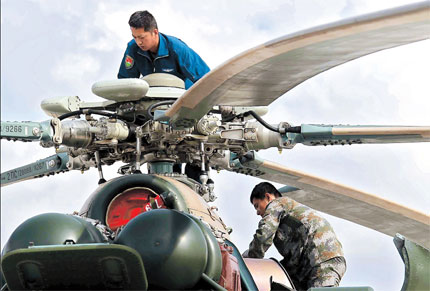Shenzhou 9 crew return about 10 a.m.
 0 Comment(s)
0 Comment(s) Print
Print E-mail Xinhua, June 29, 2012
E-mail Xinhua, June 29, 2012
|
 |
|
Helicopter crew members yesterday make final checks to ensure their machines are ready to be deployed in a search mission when China's Shenzhou-9 spacecraft and its three astronauts make their return to Earth. [Shanghai Daily] |
The Shenzhou 9 manned spacecraft will return to Earth around 10 a.m. Beijing Time Friday, a spokesperson for China's manned space program announced Thursday.
A manual operation successfully separated the Shenzhou-9 spacecraft and the Tiangong 1 lab module Thursday morning, according to the Beijing Aerospace Control Center.
It was the first time for China's spacecraft and target module to be manually disjoined.
The three Chinese astronauts returned to Shenzhou-9 from Tiangong 1 at 6 a.m. Beijing Time Thursday, in order to prepare for the manual separation attempt.
Liu Wang, one of the astronauts, conducted the operation to separate Shenzhou 9 and the orbiting Tiangong 1. He will continue to manually operate and direct the spacecraft to a safe distance from the lab module.
During their stay in Tiangong 1, all experiments and tests were finished as scheduled and produced valuable data, said Chen Shanguang, chief commander of the mission's astronaut system.
"The data will help us improve technologies for astronauts' future, long-term stays in a space station," he said.
All data and samples have been moved to the return capsule of the spacecraft, and the lab module has been restored to its pre-docking status, said the control center.
Tiangong1 will return to its previous orbit and wait for another spacecraft.
The lab module is designed to operate for two years and host six docking procedures. It has been operating for 272 days and undergone four docking procedures with the Shenzhou-8 and Shenzhou 9 spaceships, to date.
"Based on current conditions, the service of Tiangong 1 can be extended," said He Yu, chief commander of the Shenzhou 9 spacecraft. "It has consumed less than one-fourth of its fuel and no back-up systems have been used."
If the systems were improved and its operation was under careful monitoring and control, the service could be much longer, he said.
"If Tiangong 1 was in perfect shape, it could work side by side with Tiangong 2, which will be launched in the future," he said.
The Shenzhou 9 spacecraft carried the astronauts, including the first Chinese female, into space on June 16 from a launch center in northwest China's Gobi desert.
On Sunday, the astronauts successfully completed a manual docking between Shenzhou 9 and Tiangong 1, the first such attempt in China's history of space exploration, after an automated docking on June 18.
The success of the procedures shows that China has completely grasped space rendezvous and docking technologies and the country is fully capable of transporting humans and cargo to an orbiter in space, which is essential for the country's plans to build a space station around 2020.
Chinese President Hu Jintao spoke with the astronauts through a video communication system at the Beijing Aerospace Control Center on Tuesday.
The president thanked the astronauts for their contributions and wished them a "successful and safe return."






Go to Forum >>0 Comment(s)